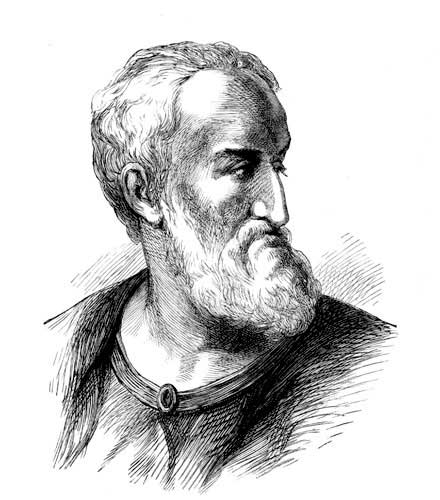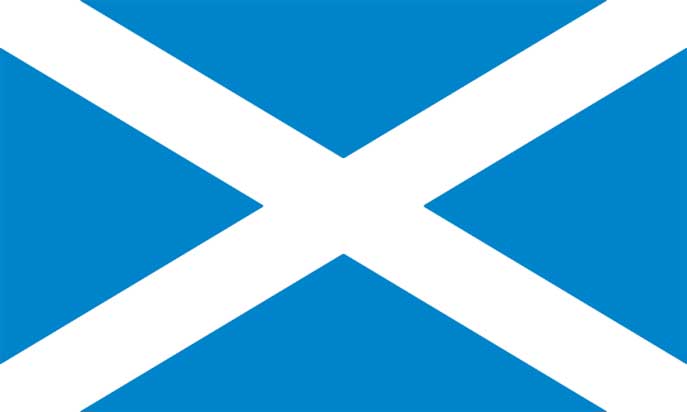SAINT ANDREW |
 |
Saint Andrew is the Patron Saint of Scotland, and St. Andrew's Day is celebrated by Scots around the world on the 30th November. The flag of Scotland is the Cross of St. Andrew, and this is widely displayed as a symbol of national identity. The "Order of Saint Andrew" or the "Most Ancient Order of the Thistle" is an order of Knighthood which is restricted to the King or Queen and sixteen others. It was established by James VII of Scotland in 1687. St. Andrew is said to have been responsible for spreading the tenets of the Christian religion though Asia Minor and Greece. Tradition suggests that St. Andrew was put to death by the Romans in Patras, Southern Greece by being pinned to a cross crucified). |
new capital Constantinople (now Istambul in Turkey). Legend suggests that a Greek Monk (although others describe him as an Irish assistant of St. Columba) called St. Rule (or St. Regulus) was warned in a dream that St. Andrews remains were to be moved and was directed by an angel to take those of the remains which he could to the "ends of the earth" for safe-keeping. St. Rule dutifully followed these directions, removing a tooth, an arm bone, a kneecap and some fingers from St. Andrew's tomb and transporting these as far away as he could. Scotland was close to the extremities of the know world at that time and it was here that St. Rule was shipwrecked with his precious cargo. St. Rule is said to have come ashore at a Pictish settlement on the East Coast of Scotland and this later became St. Andrews. Thus the association of St. Andrew with Scotland was said to have begun. Perhaps more likely than the tale of St. Rule's journey is that Acca, the Bishop of Hexham, who was a renown collector of relics, brought the relics of St. Andrew to St. Andrews in 733. There certainly seems to have been a religious centre at St. Andrews at that time, either founded by St. Rule in the 6th century or by a Pictish King, Ungus, who reigned from 731 - 761. Whichever tale is true, the relics were placed in a specially constructed chapel. This chapel was replaced by the Cathedral of St. Andrews in 1160, and St. Andrews became the religious capital of Scotland and a great centre for Medieval pilgrims who came to view the relics. There are other legends of how St. Andrew and his remains became associated with Scotland, but there is little evidence for any of these, including the legend of St. Rule. The names still exist in Scotland today, including St. Rules Tower, which remains today amongst the ruins of St. Andrews Cathedral. It is not known what happened to the relics of St. Andrew which were stored in St. Andrews Cathedral, although it is most likely that these were destroyed during the Scottish Reformation. The Protestant cause, propounded by Knox, Wishart and others, won out over Roman Catholism during the Reformation and the "idolatry of catholism", that is the Saints, relics, decoration of churches, were expunged during the process of converting the Roman Catholic churches of Scotland to the harsh simplicity of Knox's brand of Calvanism. The place where these relics were kept within the Cathedral at St. Andrews is now marked by a plaque, amongst the ruins, for visitors to see. The larger part of St. Andrew's remains were stolen from Constantinople in 1210 and are now to be found in Amalfi in Southern Italy. In 1879 the Archbishop of Amalfi sent a small piece of the Saint's shoulder blade to the re-established Roman Catholic community in Scotland. In 1969, Gordon Gray, leader of the Roman Catholic Church in Scotland was in Rome to be appointed the first Scottish Cardinal since the Reformation. Pope Paul VI gave him further relics of St. Andrew with the words "Saint Peter gives you his brother". These are now displayed in a reliquary in St. Mary's Roman Catholic Cathedral in Edinburgh. |
 |
 |
© Paisley Tartan Army 2008-09
